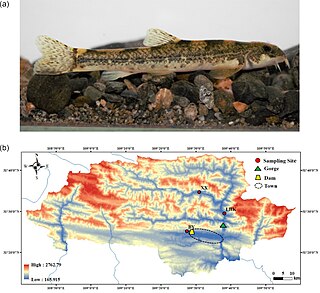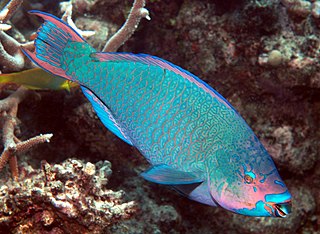Squalus is a genus of dogfish sharks in the family Squalidae. Commonly known as spurdogs, these sharks are characterized by smooth dorsal fin spines, teeth in upper and lower jaws similar in size, caudal peduncle with lateral keels; upper precaudal pit usually present, and caudal fin without subterminal notch. In spurdogs, the hyomandibula is oriented at a right angle to the neurocranium, while in other sharks, the hyomandibula runs more parallel to the body. This led some to think that the upper jaw of Squalus would not be as protractile as the jaws of other sharks. However, a study that compared different jaw suspension types in sharks showed that this is not the case and that Squalus is quite capable of protruding its upper jaw during feeding.

Squalus altipinnis, the western highfin spurdog, is a dogfish of the family Squalidae found on the continental shelf off Western Australia, at depths between 220 and 510 m. Its reproduction is ovoviviparous.

Triplophysa is a genus of fish in the family Nemacheilidae found mainly in and around the Qinghai-Tibet Plateau in China. Currently, the genus is a mixed assemblage of species. Some lineages have been identified and treated as subgenera, but as Wikipedia follows Fishbase for fish species all but Hedinichthys have been treated as subgenera in Wikipedia, although Kottelat in his revision of the loaches did recognise them as valid. FishBase, however, includes these in Triplophysa without specifying subgenera and treats the names given by Kottelat as synonyms.
Parambassis altipinnis, commonly known as the high-finned glass perchlet, is a species of fish in the family Ambassidae. It is endemic to West Papua in Indonesia.
Triplophysa arnoldii is a species of stone loach in the genus Triplophysa. It is endemic to Mongolia. It grows to 7 cm (2.8 in) SL.

Triplophysa bleekeri is a species of stone loach in the genus Triplophysa. It is endemic to China. It grows to 8.2 cm (3.2 in) TL. Having a wide distribution across the Qinghai-Tibet Plateau, it lives in fast-flowing rivers from 200 to 3,000m in altitude. Being an unusual species inhabiting high-altitude regions, it is an excellent model to investigate the genetic mechanisms of adaptation to the local environment. With this in mind a chromosomal-scale genome assembly was sequenced and assembled with a genome size of ∼628 Mb. This data finding that the Triplophysa genus likely diverged when the Qinghai-Tibet Plateau elevated by >4,000 m roughly 40 million years ago.
Triplophysa coniptera is a species of stone loach in the genus Triplophysa. It occurs in the Talas River basin, Kyrgyzstan, and the middle Syr Darya basin, Uzbekistan. The latter population may qualify as the subspecies salari.
Triplophysa flavicorpus is a species of stone loach in the genus Triplophysa endemic to the Hongshui River in Guangxi, China. It grows to 10.4 cm (4.1 in) SL.
Triplophysa gracilis is a species of stone loach in the genus Triplophysa. It is found in Pakistan, India, and China. It grows to 11 cm (4.3 in) SL and lives in standing waters and deeper parts of rivers.

Triplophysa intermedia is a species of ray-finned fish in the genus Triplophysa. The species has only been found in Hulun Lake in Inner Mongolia, China; but is believed to appear in other locations as well since fish in this genus are typically found in running water.
Triplophysa longipectoralis is a cave-living species of stone loach with vestigial eyes. The fish lives in clear water at temperatures below 20 °C. The holotype was caught in Xunle town, Huanjiang Maonan Autonomous County in the Liu River basin, Guangxi, China and was described by Zheng et al. in 2009.
Triplophysa microphysa is a species of ray-finned fish in the genus Triplophysa.
Triplophysa siluroides is a large species of stone loach, which is endemic to the upper parts of the Yellow River basin in the Chinese provinces of Qinghai, Gansu and Sichuan.
Triplophysa stenura is a species of ray-finned fish in the genus Triplophysa. It lives in swift-flowing streams and is known from the Upper Yangtze, Upper Mekong, Upper Salween and Upper Brahmaputra river drainages in China and Vietnam. Whether this apparently widespread species really is one species needs to be studied. It grows to 13.8 cm (5.4 in) SL.
Triplophysa turpanensis is a species of stone loach in the genus Triplophysa. It is endemic to Xinjiang in extreme western China. It grows to 7.7 cm (3.0 in) SL.
Triplophysa xiangshuingensis is a species of ray-finned fish in the genus Triplophysa endemic to Yunnan, China.
Enneapterygius altipinnis also known as the highfin triplefin is a species of triplefin blenny in the genus Enneapterygius. It is found in the Red Sea. It was regarded as a synonym of Enneapterygius tutuilae but in 2018 the species was reinstated as being valid.

Solomon Markovich Herzenstein was a Russian zoologist.

Scarus altipinnis, the filament-finned parrotfish, high-fin parrotfish or mini-fin parrotfish, is a species of marine ray-finned fish, a parrotfish from the family Scaridae. It occurs in the tropical and subtropical Western Pacific Ocean.
Pimelodella altipinnis is a species of three-barbeled catfish of the family Heptapteridae. It is endemic to the Essequibo River basin in Guyana. This species reaches a standard length of 6.4 cm (2.5 in).





